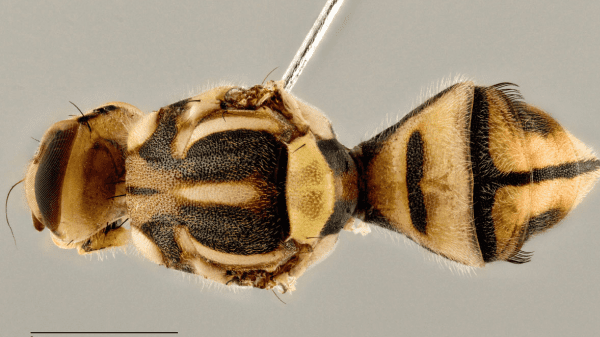When I moved to San Francisco in 1980, California was in the midst of Medfly madness. You could walk down Telegraph Avenue, the main drag in Berkeley, and buy little jewelry Medflies from street vendors.
“The Medfly is one of the world’s most destructive pests, attacking over 200 fruits and vegetables,” notes the federal Animal and Plant Health Inspection Service (APHIS).

“In June 1980, it was discovered in two highly populated urban areas in the Santa Clara Valley of northern California. APHIS and the California Department of Food and Agriculture (CDFA) began eradication activities within days. However, the overall eradication program lasted more than 27 months—and APHIS and CDFA needed to adjust and adapt their methods along the way to achieve success.”
The Medfly is the Mediterranean fruit fly, and it was a source of national attention and sometimes comedy. Late-night host Johnny Carson did a skit in which he was interviewed dressed as a Medfly.
After a number of false steps (Californians didn’t like having malathion sprayed all over their neighborhoods), the Medfly was declared eradicated in September 1982 (although it has been found sporadically since then). Nevertheless, the state’s initially chaotic response contributed to the defeat of then-Governor Jerry Brown in his drive for reelection two months later.
These memories drift to mind as California faces its latest fruit fly threat: the Tau fly, Bactrocera (Zeugodacus) tau, which is native to Asia.
Over 20 Tau flies were discovered in the vicinity of Stevenson Ranch, a community in northern Los Angeles County. They are believed to have been brought into the state by travelers taking back imported fruit. The insects feed on a long list of fruits and vegetables, including melons, okra, peppers, papayas, citrus, cucumbers, pumpkins, avocados, tomatoes, and gourds. They are considered a significant pest of cucurbits. Bactrocera latifrons FO_SPRO.docx (ca.gov)
The state has imposed a 79-square-mile quarantine area in sites where the Tau fly has been found. Tau_PQM_Overview_LosAngeles.pdf (ca.gov)
Fruit found infested in this area cannot be taken outside it but can be eaten and even processed. The state requires infested products that are not consumed to be double-bagged and thrown away in locations specifically designed for garbage (that is, not green waste disposal areas). Officials will treat infested areas with Spinosad, a natural pesticide made from soil bacteria. New invasive fruit fly found in California (farmprogress.com)
The discovery of a new pest is never good news, but it is a sign of hope to see that the authorities have learned hard lessons from the past (including the Medfly crisis) and, we can believe, are handling the problem better than they had in the past.
At least that is what APHIS tells us: after the Medfly crisis, “APHIS and its partners have made great strides in improving fruit fly traps to detect these invaders earlier and in using more environmentally friendly methods. The fruit fly preventive sterile release programs in California and Florida, which continue today, are a legacy of the hard-fought Medfly battles of the 1980s.”



